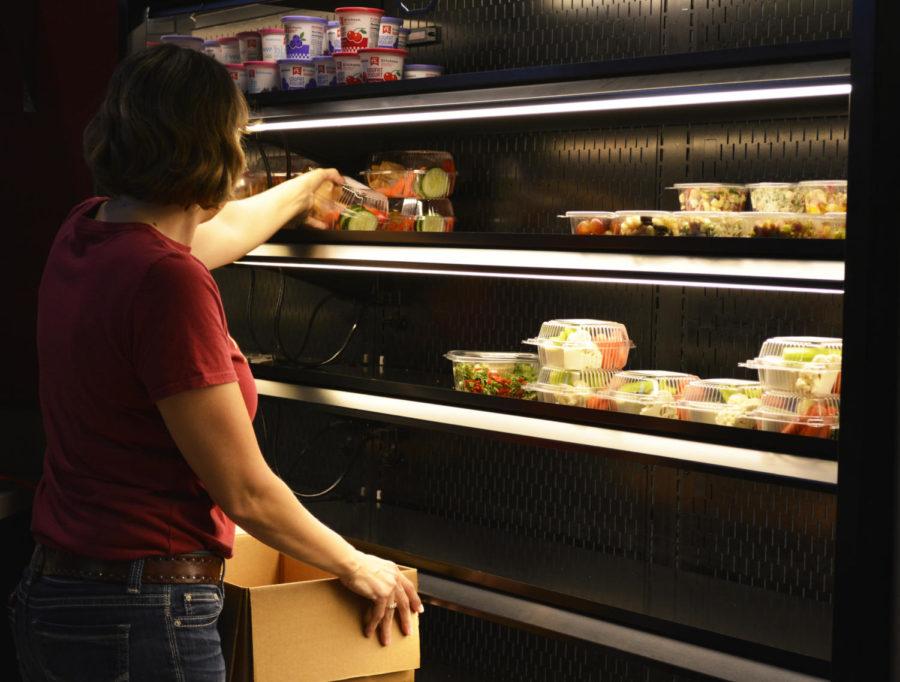Student-run Food Recovery Network eliminates food waste on campus
September 22, 2017
Student volunteers spend every Friday afternoon recovering spare food from dining cafés on campus.
The Food Recovery Network student chapter collects food that will soon expire so that it can be donated instead of wasted. The food is sorted and weighed before being distributed to Food at First, a free meal program and perishable food pantry. The FRN student chapter was created in the fall of 2015 and has since obtained official club status.
The FRN student chapter was co-founded by Autumn Rudlong, senior in food science.
When Rudlong was a freshman in one of her food science classes the national Food Recovery Network organization was shown in a brief slide during a lesson. Thinking that FRN sounded cool, Rudlong reached out to the national organization to inquire about starting a chapter at Iowa State.
“[Food waste] was an issue that I thought needed to be addressed because I knew that [ISU] Dining did compost a lot of their food but I didn’t know that they didn’t compost the café food so that was a thing that I think could have been solved,” Rudlong said.
In the food recovery hierarchy designed by the Environmental Protection Agency, food should go through five processes before resorting to throwing it away entirely.
First the amount of food generated should be minimized. For Iowa State, this would mean not purchasing a surplus of food that the students aren’t able to keep up with before it expires.
The second tier is donating extra food to food pantries and soup kitchens which is what FRN primarily does. One of the most common foods wasted is bread, Rudlong said.
“When you go to a food pantry there is always bread available because bread is massively overproduced. Although bread is a staple item it doesn’t provide the nutrients that people need,” Rudlong said.
Bread that is not consumed by people at the Food at First pantry or market is then diverted to the third tier of the food recovery hierarchy: divert food scraps to animal feed.
Farmers in Iowa take the unused or stale bread from Food at First and use it to feed their livestock, along with other food items.
The fourth tier of the hierarchy revolves around using food for industrial uses like providing food waste oils for fuel conversion.
The fifth tier is composting, the primary source of recovery done through ISU Dining.
The sixth tier, the final resort, is throwing the food away so it can be put in a landfill.
Laura Merrick, faculty adviser for FRN and agronomy lecturer, teaches a world food issues class in which she requires students to do a service learning volunteer assignment.
When Merrick was introduced to the idea of having a FRN club at Iowa State she had Rudlong and Jordan Kersey, the current treasurer, tell her class about the work they sought to down with food waste on campus.
“I immediately had them come to my class right before the interval of time when I have students in my section do their food assistance related community service,” Merrick said.
Since then, students from her class have remained active with the FRN chapter at Iowa State.
Kaitlin Umlandt, junior in dietetics, found out about the FRN chapter through the world food issues class this fall and has since joined the chapter. Umlandt wanted to get involved because of the issues FRN can help tackle.
“I’m really passionate about finding solutions for [food security and food waste],” Umlandt said.
The food collected from campus cafés on Fridays is weighed once brought to Food at First. Although FRN doesn’t keep goals for how much food they want to collect, they document the weight for reference.
“I don’t think setting a goal for food recovery necessarily is a good idea just because in general we want less food because that means it’s not being wasted in the first place,” Rudlong said.
Although not required for volunteers with FRN, some students decide to volunteer at Food at First meals when they can.
Rudlong, who has volunteered to cook meals with Food at First, considers it a unique experience that strengths the bonds between the FRN partner agencies.
Rudlong recalled seeing a Food at First regular during her time cooking meals at Food at First, as she has also seen him on campus collecting soda cans from trash bins that he turns in for money.
“He’s someone who frequents Food at First and it was kind of just nice to see him there. I was like ‘oh you’re eating today. Good.’ So it’s kind of like I wouldn’t necessarily say a caring relationship but it’s kind of like I’ve seen you struggle and I know that you’re being helped right now so it’s kind of reassuring,” Rudlong said.
Funding for Iowa State’s FRN student chapter currently comes from a grant given by the Student Government.
Money is needed for purchasing the totes that are used to carry food from dining cafés to Food at First. The grant is also used for food safe containers that lock so food can stay protected once collected.
















